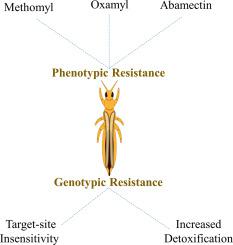当前位置:
X-MOL 学术
›
Pestic. Biochem. Phys.
›
论文详情
Our official English website, www.x-mol.net, welcomes your
feedback! (Note: you will need to create a separate account there.)
Multiple insecticide resistance in onion thrips populations from Western USA
Pesticide Biochemistry and Physiology ( IF 4.2 ) Pub Date : 2020-05-01 , DOI: 10.1016/j.pestbp.2020.104553 Adekunle W Adesanya 1 , Timothy D Waters 2 , Mark D Lavine 1 , Doug B Walsh 1 , Laura C Lavine 3 , Fang Zhu 4
Pesticide Biochemistry and Physiology ( IF 4.2 ) Pub Date : 2020-05-01 , DOI: 10.1016/j.pestbp.2020.104553 Adekunle W Adesanya 1 , Timothy D Waters 2 , Mark D Lavine 1 , Doug B Walsh 1 , Laura C Lavine 3 , Fang Zhu 4
Affiliation

|
Thrips tabaci is a key pest of onions, especially in the Pacific Northwestern USA. Management of T. tabaci is dominated by the application of various insecticides. However, T. tabaci is known to develop insecticide resistance which possibly leads to control failures, crop loss, and environmental concern. Here, we evaluated resistance status of T. tabaci populations from conventional and organic commercial onion fields to three widely used insecticides: oxamyl, methomyl, and abamectin with on-field concentration-mortality bioassays. The biochemistry and molecular mechanisms underlying resistance to these insecticides were also investigated by using enzymatic assays and detecting resistance-associated mutations. Field-evolved resistance to oxamyl, methomyl and abamectin were detected in most of the T. tabaci populations collected from conventional onion farms. At the labeled field rate, all the tested insecticides, particularly methomyl and oxamyl, had significantly reduced efficacy. Enzymatic assays of insecticide target and detoxification enzymes indicated that T. tabaci populations in Western USA onions harbor multiple mechanisms of resistance including enhanced activities of detoxification enzymes and target site insensitivity. Our results provide new information in understanding the dynamics of T. tabaci adaptation to multiple insecticides, which will help to design sustainable insecticide resistance management strategies for T. tabaci. Furthermore, this study provides the foundation for future research in identifying the biochemical and molecular markers associated with insecticide resistance in T. tabaci.
中文翻译:

美国西部洋葱蓟马种群的多种杀虫剂抗性
烟蓟马是洋葱的主要害虫,尤其是在美国太平洋西北部。烟粉虱的管理主要是使用各种杀虫剂。然而,已知烟粉虱会产生杀虫剂抗性,这可能导致防治失败、作物损失和环境问题。在这里,我们通过现场浓度-死亡率生物测定评估了传统和有机商业洋葱田中烟粉虱种群对三种广泛使用的杀虫剂:草酰、灭多威和阿维菌素的抗性状态。还通过使用酶分析和检测抗性相关突变来研究对这些杀虫剂产生抗性的生物化学和分子机制。在大多数 T 中检测到田间进化的对草酰、灭多威和阿维菌素的抗性。从传统洋葱农场收集的烟粉虱种群。在标记的田间施用率下,所有测试的杀虫剂,尤其是灭多威和草酰,都显着降低了药效。杀虫剂靶标和解毒酶的酶促测定表明,美国西部洋葱中的烟粉虱种群具有多种抗性机制,包括解毒酶活性增强和靶位不敏感。我们的研究结果为了解烟粉虱对多种杀虫剂的适应动态提供了新信息,这将有助于为烟粉虱设计可持续的杀虫剂抗性管理策略。此外,这项研究为未来确定与烟粉虱杀虫剂抗性相关的生化和分子标记的研究奠定了基础。在标记的田间施用率下,所有测试的杀虫剂,尤其是灭多威和草酰,都显着降低了药效。杀虫剂靶标和解毒酶的酶促测定表明,美国西部洋葱中的烟粉虱种群具有多种抗性机制,包括解毒酶活性增强和靶位不敏感。我们的研究结果为了解烟粉虱对多种杀虫剂的适应动态提供了新信息,这将有助于为烟粉虱设计可持续的杀虫剂抗性管理策略。此外,这项研究为未来确定与烟粉虱杀虫剂抗性相关的生化和分子标记的研究奠定了基础。在标记的田间施用率下,所有测试的杀虫剂,尤其是灭多威和草酰,都显着降低了药效。杀虫剂靶标和解毒酶的酶促测定表明,美国西部洋葱中的烟粉虱种群具有多种抗性机制,包括解毒酶活性增强和靶位不敏感。我们的研究结果为了解烟粉虱对多种杀虫剂的适应动态提供了新信息,这将有助于为烟粉虱设计可持续的杀虫剂抗性管理策略。此外,这项研究为未来确定与烟粉虱杀虫剂抗性相关的生化和分子标记的研究奠定了基础。疗效明显降低。杀虫剂靶标和解毒酶的酶促测定表明,美国西部洋葱中的烟粉虱种群具有多种抗性机制,包括解毒酶活性增强和靶位不敏感。我们的研究结果为了解烟粉虱对多种杀虫剂的适应动态提供了新信息,这将有助于为烟粉虱设计可持续的杀虫剂抗性管理策略。此外,这项研究为未来确定与烟粉虱杀虫剂抗性相关的生化和分子标记的研究奠定了基础。疗效明显降低。杀虫剂靶标和解毒酶的酶促测定表明,美国西部洋葱中的烟粉虱种群具有多种抗性机制,包括解毒酶活性增强和靶位不敏感。我们的研究结果为了解烟粉虱对多种杀虫剂的适应动态提供了新信息,这将有助于为烟粉虱设计可持续的杀虫剂抗性管理策略。此外,这项研究为未来确定与烟粉虱杀虫剂抗性相关的生化和分子标记的研究奠定了基础。美国西部洋葱中的烟粉虱种群具有多种抗性机制,包括增强解毒酶的活性和靶位不敏感。我们的研究结果为了解烟粉虱对多种杀虫剂的适应动态提供了新信息,这将有助于为烟粉虱设计可持续的杀虫剂抗性管理策略。此外,这项研究为未来确定与烟粉虱杀虫剂抗性相关的生化和分子标记的研究奠定了基础。美国西部洋葱的烟粉虱种群具有多种抗性机制,包括增强的解毒酶活性和靶位不敏感性。我们的研究结果为了解烟粉虱对多种杀虫剂的适应动态提供了新信息,这将有助于为烟粉虱设计可持续的杀虫剂抗性管理策略。此外,这项研究为未来确定与烟粉虱杀虫剂抗性相关的生化和分子标记的研究奠定了基础。
更新日期:2020-05-01
中文翻译:

美国西部洋葱蓟马种群的多种杀虫剂抗性
烟蓟马是洋葱的主要害虫,尤其是在美国太平洋西北部。烟粉虱的管理主要是使用各种杀虫剂。然而,已知烟粉虱会产生杀虫剂抗性,这可能导致防治失败、作物损失和环境问题。在这里,我们通过现场浓度-死亡率生物测定评估了传统和有机商业洋葱田中烟粉虱种群对三种广泛使用的杀虫剂:草酰、灭多威和阿维菌素的抗性状态。还通过使用酶分析和检测抗性相关突变来研究对这些杀虫剂产生抗性的生物化学和分子机制。在大多数 T 中检测到田间进化的对草酰、灭多威和阿维菌素的抗性。从传统洋葱农场收集的烟粉虱种群。在标记的田间施用率下,所有测试的杀虫剂,尤其是灭多威和草酰,都显着降低了药效。杀虫剂靶标和解毒酶的酶促测定表明,美国西部洋葱中的烟粉虱种群具有多种抗性机制,包括解毒酶活性增强和靶位不敏感。我们的研究结果为了解烟粉虱对多种杀虫剂的适应动态提供了新信息,这将有助于为烟粉虱设计可持续的杀虫剂抗性管理策略。此外,这项研究为未来确定与烟粉虱杀虫剂抗性相关的生化和分子标记的研究奠定了基础。在标记的田间施用率下,所有测试的杀虫剂,尤其是灭多威和草酰,都显着降低了药效。杀虫剂靶标和解毒酶的酶促测定表明,美国西部洋葱中的烟粉虱种群具有多种抗性机制,包括解毒酶活性增强和靶位不敏感。我们的研究结果为了解烟粉虱对多种杀虫剂的适应动态提供了新信息,这将有助于为烟粉虱设计可持续的杀虫剂抗性管理策略。此外,这项研究为未来确定与烟粉虱杀虫剂抗性相关的生化和分子标记的研究奠定了基础。在标记的田间施用率下,所有测试的杀虫剂,尤其是灭多威和草酰,都显着降低了药效。杀虫剂靶标和解毒酶的酶促测定表明,美国西部洋葱中的烟粉虱种群具有多种抗性机制,包括解毒酶活性增强和靶位不敏感。我们的研究结果为了解烟粉虱对多种杀虫剂的适应动态提供了新信息,这将有助于为烟粉虱设计可持续的杀虫剂抗性管理策略。此外,这项研究为未来确定与烟粉虱杀虫剂抗性相关的生化和分子标记的研究奠定了基础。疗效明显降低。杀虫剂靶标和解毒酶的酶促测定表明,美国西部洋葱中的烟粉虱种群具有多种抗性机制,包括解毒酶活性增强和靶位不敏感。我们的研究结果为了解烟粉虱对多种杀虫剂的适应动态提供了新信息,这将有助于为烟粉虱设计可持续的杀虫剂抗性管理策略。此外,这项研究为未来确定与烟粉虱杀虫剂抗性相关的生化和分子标记的研究奠定了基础。疗效明显降低。杀虫剂靶标和解毒酶的酶促测定表明,美国西部洋葱中的烟粉虱种群具有多种抗性机制,包括解毒酶活性增强和靶位不敏感。我们的研究结果为了解烟粉虱对多种杀虫剂的适应动态提供了新信息,这将有助于为烟粉虱设计可持续的杀虫剂抗性管理策略。此外,这项研究为未来确定与烟粉虱杀虫剂抗性相关的生化和分子标记的研究奠定了基础。美国西部洋葱中的烟粉虱种群具有多种抗性机制,包括增强解毒酶的活性和靶位不敏感。我们的研究结果为了解烟粉虱对多种杀虫剂的适应动态提供了新信息,这将有助于为烟粉虱设计可持续的杀虫剂抗性管理策略。此外,这项研究为未来确定与烟粉虱杀虫剂抗性相关的生化和分子标记的研究奠定了基础。美国西部洋葱的烟粉虱种群具有多种抗性机制,包括增强的解毒酶活性和靶位不敏感性。我们的研究结果为了解烟粉虱对多种杀虫剂的适应动态提供了新信息,这将有助于为烟粉虱设计可持续的杀虫剂抗性管理策略。此外,这项研究为未来确定与烟粉虱杀虫剂抗性相关的生化和分子标记的研究奠定了基础。











































 京公网安备 11010802027423号
京公网安备 11010802027423号